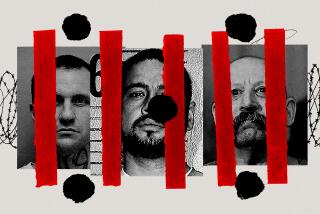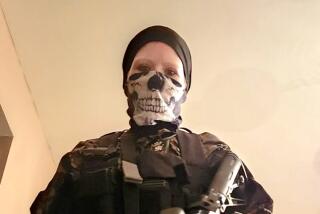Sikh temple shooter seems to have followed âlone wolfâ path
MILWAUKEE â Law enforcement has pored through more than 100 leads following the shootings that left six people dead at a Sikh temple this week, trying to determine whether gunman Wade Michael Page acted alone or was part of a group bent on carrying out acts of neo-Nazi violence.
So far, it has led to the same dark image: a 40-year-old skinhead band guitarist who stepped alone out of his SUV, walked alone to the temple, fired a Springfield Armory XDM handgun at the elderly turbaned priests and other worshipers inside and finally, crippled by a police marksmanâs bullet, fired a fatal round into his own head.
âAfter all this work, we still have identified no one else responsible for the shooting, other than him. We also have not clearly identified a motive at this point,â Teresa Carlson, special agent in charge of the FBI in Milwaukee, said at a news conference Wednesday.
To which her assistant agent in charge, Steven Conley, added a perplexing coda: âWe may never know,â he said. âWhy that building? That temple? At that time? That may have died with Page.â
In the public debate over the rise of hate groups in the U.S. and the search for signs of neo-Nazi plots, analysts say Pageâs one-man campaign of terror fits solidly into an established tradition of âlone wolfâ violence that has countless precedents on the fringes of racist American thought.
Many prominent U.S. neo-Nazi groups have condemned the Sikh temple shootings and denounced Page for discrediting the movement. But right-wing extremist literature is rife with treatises that embody the idea of a single man driven to lonely acts of murder for the protection of his race and culture.
Far-right websites have lionized men like Robert Jay Mathews, who died in a blazing battle with 75 law enforcement agents in Washington state in 1984 after organizing a âwhite American bastionâ group that became the Order, the most notorious domestic terrorist cell of the 1980s.
âThe whole idea of white warriors. Itâs an integral part of the neo-Nazi and white supremacist subculture,â said Brian Levin, director of the Center for the Study of Hate and Extremism at Cal State San Bernardino.
âTheyâve always talked about the notion of the âpropaganda of the deed,â where you go out and you commit a terrible atrocity against a defined enemy in a manner that glorifies the movement without in any way giving away what your motive is,â he said. âAnd in that sense, itâs interesting that Page killed himselfâ â leaving his own trail shrouded in questions.
Solitary gunmen with racist ideologies figure heavily in the trail of mass shootings of recent years. In Los Angeles, former Aryan Nations security guard Buford O. Furrow Jr. opened fire in a care center in Granada Hills in 1999, injuring four people, and fatally shot a Filipino American postal carrier.
Benjamin Smith, an avowed follower of the âracial holy warâ movement, engaged in a two-state, drive-by shooting spree the same year in Illinois and Indiana that killed two people and injured 11 before, under hot pursuit by the police, shooting himself in the head.
In 2009, Richard Poplawski, who had expressed racist views on extremist websites, fatally shot three police officers in Pennsylvania.
Two years later, a lone gunman who advocated the violent annihilation of âEurabia,â bombed government buildings, killing eight people, and struck a youth summer camp in Norway, leaving 69 people dead, many of them teenagers.
None of these perpetrators was acting on specific orders of any radical organization, yet all in some ways followed a tradition of âleaderless resistanceâ outlined most prominently by Texas white nationalist Louis Beam in 1983.
âBeam argued that under current conditions, it was really impossible to have any kind of resistance in an organized setting,â said George Michael, an associate professor at the U.S. Air War College who wrote a book published this year, âLone Wolf Terror and the Rise of Leaderless Resistance.â
âHe said that it would have to be leaderless. That people would take it on themselves to educate themselves on issues and try to find the soft targets of the system. It was a personâs responsibility to act as he saw fit.â
William Pierce, whose book âThe Turner Diariesâ became a Bible to the far-right fringe after it was discovered that Oklahoma City bomber Timothy McVeigh had read it closely, followed that up with a lesser-known work that is also widely popular in the far right: âHunter,â which tells the fictional story of a former Vietnam War fighter pilot who becomes a lone-wolf assassin killing interracial couples, and then Jews, in the hope that it might encourage others to replicate his acts.
The FBI in 2009 began a tracking system designed to identify and monitor individuals with âlone offender behavioral traitsâ likely to commit ideological slayings.
Page was not the subject of any active investigations, FBI officials have said, but Levin said the temple gunman displayed many of the traits common to white supremacist assassins: personal and social isolation, moving from place to place, problems at work, problems with women, drug or alcohol use, and eventually, attraction to weaponry.
The number of hate groups has been on the rise in recent years, according to the Southern Poverty Law Center, yet the number of racist slayings has been at a 14-year low, Levin said, with fewer than a dozen a year over the last decade, and overall membership in extreme racist organizations is down.
For one thing, analysts say, avowed racists tend to congregate now on the Internet, rather than at cross-burning rallies. âAnother thing is that young people now are more tolerant than theyâve ever been, so the people who join these groups are much more socially isolated now,â Levin said.
Thanks in part to surveillance and informant networks, most potential lone wolves get caught before they act, said Scott Stewart, an analyst with Stratfor Global Intelligence.
âThereâs almost never one of these guys who doesnât somehow tip off what heâs doing beforehand,â Stewart said. âThey usually screw up.â
More to Read
Sign up for Essential California
The most important California stories and recommendations in your inbox every morning.
You may occasionally receive promotional content from the Los Angeles Times.










